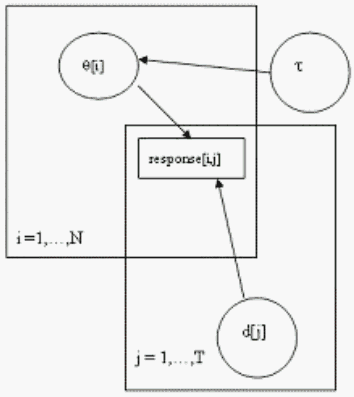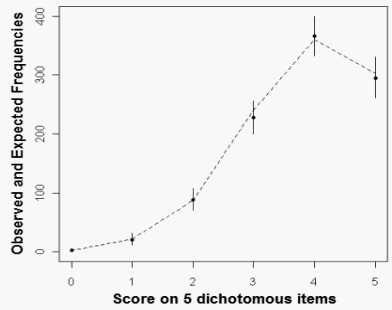
Figure 1. Bayesian Graph of the Rasch Model
| ||||||||||||||||||||||||||
Empirical Results and Model Checking
We illustrate our approach using the classical example in educational testing - the Law School Admission Test (LSAT) data, which is available in the R package called ltm (Latent Trait Model). The data contain responses of 1000 individuals to five items which were designed to measure a single latent ability. Here are the results obtained using WinBUGS. "ltm" are the R statistics as estimates for reference.
| Estimates of Item difficulty | ||||||
|---|---|---|---|---|---|---|
| Item | mean | sd | 2.5% | median | 97.5% | ltm |
| 1 | -2.74 | 0.13 | -3.00 | -2.74 | -2.49 | -2.87 |
| 2 | -1 | 0.08 | -1.15 | -1 | -0.84 | -1.06 |
| 3 | -0.24 | 0.07 | -0.38 | -0.24 | -0.1 | -0.26 |
| 4 | -1.31 | 0.08 | -1.47 | -1.31 | -1.14 | -1.39 |
| 5 | -2.1 | 0.11 | -2.31 | -2.1 | -1.9 | -2.22 |
We can see that the estimated values from WinBUGS are close to the ones from ltm which uses a Marginal Maximum Likelihood (MMLE) approach. As the observed data are discrete, one common method of model checking in Bayesian approach is to draw samples from posterior predictive distribution and compare the simulated frequencies of different possible outcomes with the observed ones. Here are the results of model checking.
The model checking statistics are displayed in the graph below. The observed frequencies are shown by a dashed line. The expected frequencies are shown by vertical bars. We can conclude that the observed outcomes are very close to the predicted ones.
| Obs Freq | Expected Frequency | |||||
| Score | mean | sd | 2.5% | median | 97.5% | |
| 0 | 3 | 2.4 | 1.6 | 0 | 2 | 6 |
| 1 | 21 | 20.6 | 5.1 | 11 | 20 | 31 |
| 2 | 87 | 88.2 | 9.7 | 70 | 88 | 107 |
| 3 | 240 | 228.1 | 14.5 | 200 | 228 | 256 |
| 4 | 361 | 366.0 | 17.1 | 333 | 366 | 399 |
| 5 | 303 | 294.8 | 17.6 | 261 | 295 | 330 |

Figure 2. Observed and Expected Frequencies | |
| Forum | Rasch Measurement Forum to discuss any Rasch-related topic |
Go to Top of Page
Go to index of all Rasch Measurement Transactions
AERA members: Join the Rasch Measurement SIG and receive the printed version of RMT
Some back issues of RMT are available as bound volumes
Subscribe to Journal of Applied Measurement
Go to Institute for Objective Measurement Home Page. The Rasch Measurement SIG (AERA) thanks the Institute for Objective Measurement for inviting the publication of Rasch Measurement Transactions on the Institute's website, www.rasch.org.
| Coming Rasch-related Events | |
|---|---|
| Jan. 16 - Feb. 13, 2025, Fri.-Fri. | On-line workshop: Rasch Measurement - Core Topics (E. Smith, Winsteps), www.statistics.com |
| Apr. 8 - Apr. 11, 2026, Wed.-Sat. | National Council for Measurement in Education - Los Angeles, CA, ncme.org/events/2026-annual-meeting |
| Apr. 8 - Apr. 12, 2026, Wed.-Sun. | American Educational Research Association - Los Angeles, CA, www.aera.net/AERA2026 |
| May. 15 - June 12, 2026, Fri.-Fri. | On-line workshop: Rasch Measurement - Core Topics (E. Smith, Winsteps), www.statistics.com |
| June 19 - July 25, 2026, Fri.-Sat. | On-line workshop: Rasch Measurement - Further Topics (E. Smith, Winsteps), www.statistics.com |
The URL of this page is www.rasch.org/rmt/rmt231e.htm
Website: www.rasch.org/rmt/contents.htm